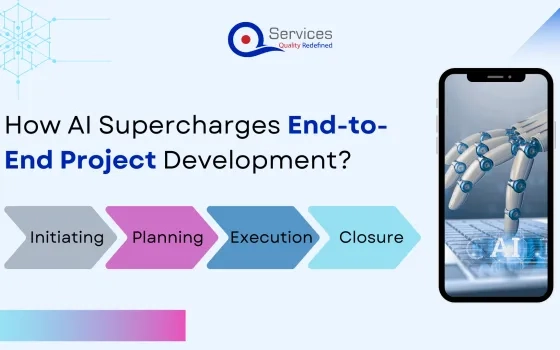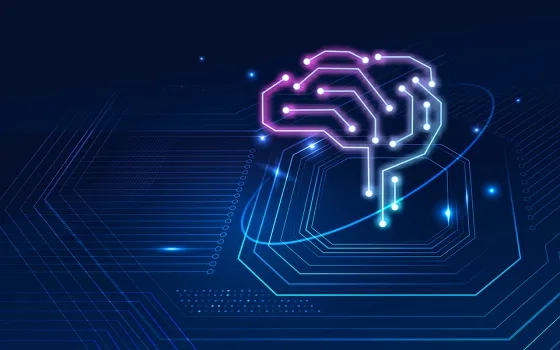In the constantly changing landscape, AI proves to be an exception for the software development industry. According to a study conducted by McKinsey, AI-driven automation can improve productivity by 40% in certain tasks. Studies also show that AI-powered code completion and suggestion tools can boost developer’s productivity by 20-30%. AI can not only reduce human errors but can also be beneficial for saving time in the completion of a project.
Artificial intelligence (AI) is leading the way toward a new era of improved efficiency and effectiveness in project management. According to a 2023 PMI survey, project managers whose organizations fully integrate AI are 30% more likely to achieve on-time delivery and 23% more likely to meet or surpass ROI estimates. In the world of project management AI is the main factor that levels up the speed and accuracy which drastically improves the project management process.
What is end-to-end project development and why is it important?
End-to-end project development refers to the overall process of creating a complete solution or product from conception to deployment and beyond. It involves all the stages of the project lifecycle, from defining the initial requirements to delivering a fully functional and maintainable solution. Benefits of end-to-end project development:
Comprehensive Solution Delivery
End-to-end project development ensures that from initial concept to final deployment and maintenance, all aspects of a solution are addressed. This comprehensive approach helps in delivering a complete and functional solution that meets all the needs of stakeholders.
Holistic Approach
End-to-end development encompasses all project phases, from requirement gathering to designing, testing, deployment, and ongoing support. This approach helps to prevent isolated development efforts where individual components function independently but struggle to integrate smoothly.
Efficient Resource Utilization
A project or process can achieve its goals with minimum wastage of resources, time, and effort. Efficient projects make optimal use of available resources, such as workforce talent, materials, and equipment. By streamlining development, testing, and deployment activities, organizations can maximize productivity and minimize the wastage of resources.
Risk Mitigation
Effective project management promptly identifies and addresses risks. By breaking the project into manageable phases and iterations, end-to-end development aids in mitigating risks linked with complex projects. Detecting and resolving issues early can significantly reduce the likelihood of expensive rework or project failures. Proactive risk management further serves to avert costly setbacks.
Quality Assurance
Employing a systematic approach to project development facilitates the early identification and resolution of potential issues. With comprehensive testing and quality assurance measures, end-to-end development guarantees that the solution adheres to quality standards and functions reliably in production environments.
Customer Satisfaction
A well-executed end-to-end development process results in a solution to meet customer expectations. By involving stakeholders throughout the project lifecycle and delivering high-quality products, organizations can enhance customer satisfaction and build long-term relationships.
How AI Supercharges End-to-End Project Development?
The Harvard Business Review points out that a primary reason for low project success rates is the limited maturity of technologies used to manage projects. Every year, about $48 trillion is spent on projects. However, according to the Standish Group, only 35% of these projects are successful. It’s surprising how many resources are wasted, and benefits are missed in the remaining 65%. The remaining 65% encounter significant levels of wasted resources, exceeding costs, and unfulfilled benefits.
Artificial Intelligence emerges as the most valuable asset in transforming the operational methods of project teams to address this issue. The unpredictable nature of applications of AI in business reflects the continuously evolving landscape of technology. By utilizing AI technologies, businesses can optimize project development processes, improve decision-making, and achieve strategic objectives more effectively. Let’s explore how AI will help in end-to-end project development:
1. Data Collection and Analysis
AI algorithms possess the ability to collect and analyze extensive datasets from diverse sources, offering insights crucial for decision-making in the early stages of a project, especially within business intelligence and data analytics domains. This may encompass activities such as market research, analysis of user feedback, or any other pertinent data collection process. Additionally, AI tools can automate tasks related to data exploration, including summarizing statistics, visualizing distributions, and detecting patterns.
2. Requirement Analytics
AI-driven analytics tools facilitate the collection and analysis of requirements sourced from diverse outlets such as user feedback, market trends, and existing data. This streamlines the requirement analysis process through automated data gathering, sentiment analysis, prioritization, natural language comprehension, requirement traceability, and predictive analytics. Leveraging AI technologies enables organizations to enhance the precision, efficiency, and efficacy of requirement analysis, leading to superior project results and heightened customer satisfaction.
3. Automated Task Management
Automated Task Management is a vital component of harnessing AI in project development. It involves utilizing AI-powered tools and systems to streamline and automate various routine tasks throughout the project's lifespan. This revolutionizes project development by optimizing workflows and resource allocation. Advanced algorithms automatically schedule, prioritize, and track tasks, ensuring efficient progress and timely completion. AI-driven systems analyze historical data to forecast future resource needs and identify potential risks, enabling proactive mitigation strategies. Furthermore, step-by-step automation alleviates the burden of repetitive tasks, allowing team members to concentrate on higher-value activities. As projects progress, these systems adapt dynamically, continuously learning and enhancing through feedback loops. Overall, AI-driven Automated Task Management elevates project efficiency, mitigates risks, and fosters ongoing improvement across the project lifecycle.
4. Natural Language Processing (NLP)
Natural Language Understanding (NLU) is pivotal for requirement analysis, especially in interpreting natural language requirements like user stories, use cases, and feature requests. NLU systems employ algorithms to understand the semantics and context of language, ensuring they grasp the true intent behind each requirement accurately. By streamlining requirement analysis, mitigating misunderstandings, and aligning closely with stakeholder expectations, organizations benefit significantly from NLU's capabilities.
5. Designing and Planning
Designing and planning stand as significant components of efficient project development, constituting a time-consuming endeavor. Here, AI plays a pivotal role by offering assistance in designing and planning through valuable insights into user preferences, anticipation of potential issues, and generation of design recommendations. For instance, AI-driven design tools can automate tasks such as wireframing and prototyping, thereby expediting the design phase. Additionally, AI aids in automating repetitive project management tasks, thereby enabling project managers to dedicate their attention to more strategic facets of their responsibilities.
6. Development
According to the 2023 Stack Overflow survey, approximately 32.8% of developers stated that the primary advantage of integrating AI tools into their development workflow was a boost in productivity. Increasing advancements in AI have led developers to leverage various tools to save time and solve problems. AI technologies, such as generative AI prompts, enhance the project roadmap development process, thus allowing developers to design roadmaps more efficiently. By utilizing generative AI, developers can complete coding tasks up to twice, resulting in more time savings. AI significantly contributes to development workflows by improving productivity, enhancing decision-making, and accelerating project timelines.
7. Testing and Quality Assurance
AI algorithms have the capability to swiftly analyze thousands of codes, detecting anomalies, inconsistencies, and potential vulnerabilities. Unlike manual testing, AI-powered tests minimize false positives and consistently detect genuine issues. This will help developers focus on crucial issues, thus accelerating the development cycle. It transforms testing and QA by automating time-consuming tasks, improving accuracy, and offering insights that were previously unachievable. It examines historical data, identifying patterns, enabling it to forecast potential future failures or bugs. The team can adopt preventive measures guided by these predictions, thus diminishing the necessity for reactive bug fixes. AI minimizes the time required for testing and speeds up the release process. A faster testing cycle contributes to shorter time-to-market and cost savings.
8. Deployment and Monitoring
AI plays a crucial role in the deployment and monitoring by offering several benefits. It streamlines the deployment process by automating repetitive tasks such as code deployment, configuration management, and environment setup. DevOps teams have the option to utilize AI-driven tools to ensure uniform and error-free deployments across various environments such as development, staging, and production. Through decreased reliance on manual intervention, AI expedites the deployment cycle and mitigates the potential for human errors.
Continuous monitoring tools powered by AI track application performance, infrastructure health, and user experience in an ongoing manner. They help to identify anomalies, challenges, and potential issues in real time. When thresholds are exceeded, or anomalies occur, AI promptly generates alerts, allowing teams to proactively address issues before they impact users. By anticipating demand and optimizing resource allocation, AI ensures smooth deployment and scalability.
9. Maintenance and Support
AI transforms data into predictions, offering advanced notice of equipment issues before they cause disruptions in operations. It’s like having 24/7 monitoring of your machinery, anticipating problems, and recommending preemptive actions. By analyzing historical data, machine learning algorithms acquire the ability to predict equipment failures. This proactive strategy reduces downtime and boosts efficiency while keeping maintenance costs in check.
AI-powered chatbots can provide immediate assistance to users, troubleshoot common issues, and escalate complex problems to human operators when necessary. Chatbots can handle user queries and assist at any time, ensuring continuous support. They respond instantly, reducing waiting times for users. It can handle multiple conversations simultaneously. It uses NPL techniques to understand user input, even if it’s grammatically imperfect. Chatbots can automate repetitive tasks, such as providing project updates, tracking progress, or answering FAQs. They can notify users about milestones, deadlines, or changes in the project status.
In the constantly changing landscape, AI proves to be an exception for the software development industry. According to a study conducted by McKinsey, AI-driven automation can improve productivity by 40% in certain tasks. Studies also show that AI-powered code completion and suggestion tools can boost developer’s productivity by 20-30%. AI can not only reduce human errors but can also be beneficial for saving time in the completion of a project.
Artificial intelligence (AI) is leading the way toward a new era of improved efficiency and effectiveness in project management. According to a 2023 PMI survey, project managers whose organizations fully integrate AI are 30% more likely to achieve on-time delivery and 23% more likely to meet or surpass ROI estimates. In the world of project management AI is the main factor that levels up the speed and accuracy which drastically improves the project management process.
What is end-to-end project development and why is it important?
End-to-end project development refers to the overall process of creating a complete solution or product from conception to deployment and beyond. It involves all the stages of the project lifecycle, from defining the initial requirements to delivering a fully functional and maintainable solution. Benefits of end-to-end project development:
Comprehensive Solution Delivery
End-to-end project development ensures that from initial concept to final deployment and maintenance, all aspects of a solution are addressed. This comprehensive approach helps in delivering a complete and functional solution that meets all the needs of stakeholders.
Holistic Approach
End-to-end development encompasses all project phases, from requirement gathering to designing, testing, deployment, and ongoing support. This approach helps to prevent isolated development efforts where individual components function independently but struggle to integrate smoothly.
Efficient Resource Utilization
A project or process can achieve its goals with minimum wastage of resources, time, and effort. Efficient projects make optimal use of available resources, such as workforce talent, materials, and equipment. By streamlining development, testing, and deployment activities, organizations can maximize productivity and minimize the wastage of resources.
Risk Mitigation
Effective project management promptly identifies and addresses risks. By breaking the project into manageable phases and iterations, end-to-end development aids in mitigating risks linked with complex projects. Detecting and resolving issues early can significantly reduce the likelihood of expensive rework or project failures. Proactive risk management further serves to avert costly setbacks.
Quality Assurance
Employing a systematic approach to project development facilitates the early identification and resolution of potential issues. With comprehensive testing and quality assurance measures, end-to-end development guarantees that the solution adheres to quality standards and functions reliably in production environments.
Customer Satisfaction
A well-executed end-to-end development process results in a solution to meet customer expectations. By involving stakeholders throughout the project lifecycle and delivering high-quality products, organizations can enhance customer satisfaction and build long-term relationships.
How AI Supercharges End-to-End Project Development?
The Harvard Business Review points out that a primary reason for low project success rates is the limited maturity of technologies used to manage projects. Every year, about $48 trillion is spent on projects. However, according to the Standish Group, only 35% of these projects are successful. It’s surprising how many resources are wasted, and benefits are missed in the remaining 65%. The remaining 65% encounter significant levels of wasted resources, exceeding costs, and unfulfilled benefits.
Artificial Intelligence emerges as the most valuable asset in transforming the operational methods of project teams to address this issue. The unpredictable nature of applications of AI in business reflects the continuously evolving landscape of technology. By utilizing AI technologies, businesses can optimize project development processes, improve decision-making, and achieve strategic objectives more effectively. Let’s explore how AI will help in end-to-end project development:
1. Data Collection and Analysis
AI algorithms possess the ability to collect and analyze extensive datasets from diverse sources, offering insights crucial for decision-making in the early stages of a project, especially within business intelligence and data analytics domains. This may encompass activities such as market research, analysis of user feedback, or any other pertinent data collection process. Additionally, AI tools can automate tasks related to data exploration, including summarizing statistics, visualizing distributions, and detecting patterns.
2. Requirement Analytics
AI-driven analytics tools facilitate the collection and analysis of requirements sourced from diverse outlets such as user feedback, market trends, and existing data. This streamlines the requirement analysis process through automated data gathering, sentiment analysis, prioritization, natural language comprehension, requirement traceability, and predictive analytics. Leveraging AI technologies enables organizations to enhance the precision, efficiency, and efficacy of requirement analysis, leading to superior project results and heightened customer satisfaction.
3. Automated Task Management
Automated Task Management is a vital component of harnessing AI in project development. It involves utilizing AI-powered tools and systems to streamline and automate various routine tasks throughout the project's lifespan. This revolutionizes project development by optimizing workflows and resource allocation. Advanced algorithms automatically schedule, prioritize, and track tasks, ensuring efficient progress and timely completion. AI-driven systems analyze historical data to forecast future resource needs and identify potential risks, enabling proactive mitigation strategies. Furthermore, step-by-step automation alleviates the burden of repetitive tasks, allowing team members to concentrate on higher-value activities. As projects progress, these systems adapt dynamically, continuously learning and enhancing through feedback loops. Overall, AI-driven Automated Task Management elevates project efficiency, mitigates risks, and fosters ongoing improvement across the project lifecycle.
4. Natural Language Processing (NLP)
Natural Language Understanding (NLU) is pivotal for requirement analysis, especially in interpreting natural language requirements like user stories, use cases, and feature requests. NLU systems employ algorithms to understand the semantics and context of language, ensuring they grasp the true intent behind each requirement accurately. By streamlining requirement analysis, mitigating misunderstandings, and aligning closely with stakeholder expectations, organizations benefit significantly from NLU's capabilities.
5. Designing and Planning
Designing and planning stand as significant components of efficient project development, constituting a time-consuming endeavor. Here, AI plays a pivotal role by offering assistance in designing and planning through valuable insights into user preferences, anticipation of potential issues, and generation of design recommendations. For instance, AI-driven design tools can automate tasks such as wireframing and prototyping, thereby expediting the design phase. Additionally, AI aids in automating repetitive project management tasks, thereby enabling project managers to dedicate their attention to more strategic facets of their responsibilities.
6. Development
According to the 2023 Stack Overflow survey, approximately 32.8% of developers stated that the primary advantage of integrating AI tools into their development workflow was a boost in productivity. Increasing advancements in AI have led developers to leverage various tools to save time and solve problems. AI technologies, such as generative AI prompts, enhance the project roadmap development process, thus allowing developers to design roadmaps more efficiently. By utilizing generative AI, developers can complete coding tasks up to twice, resulting in more time savings. AI significantly contributes to development workflows by improving productivity, enhancing decision-making, and accelerating project timelines.
7. Testing and Quality Assurance
AI algorithms have the capability to swiftly analyze thousands of codes, detecting anomalies, inconsistencies, and potential vulnerabilities. Unlike manual testing, AI-powered tests minimize false positives and consistently detect genuine issues. This will help developers focus on crucial issues, thus accelerating the development cycle. It transforms testing and QA by automating time-consuming tasks, improving accuracy, and offering insights that were previously unachievable. It examines historical data, identifying patterns, enabling it to forecast potential future failures or bugs. The team can adopt preventive measures guided by these predictions, thus diminishing the necessity for reactive bug fixes. AI minimizes the time required for testing and speeds up the release process. A faster testing cycle contributes to shorter time-to-market and cost savings.
8. Deployment and Monitoring
AI plays a crucial role in the deployment and monitoring by offering several benefits. It streamlines the deployment process by automating repetitive tasks such as code deployment, configuration management, and environment setup. DevOps teams have the option to utilize AI-driven tools to ensure uniform and error-free deployments across various environments such as development, staging, and production. Through decreased reliance on manual intervention, AI expedites the deployment cycle and mitigates the potential for human errors.
Continuous monitoring tools powered by AI track application performance, infrastructure health, and user experience in an ongoing manner. They help to identify anomalies, challenges, and potential issues in real time. When thresholds are exceeded, or anomalies occur, AI promptly generates alerts, allowing teams to proactively address issues before they impact users. By anticipating demand and optimizing resource allocation, AI ensures smooth deployment and scalability.
9. Maintenance and Support
AI transforms data into predictions, offering advanced notice of equipment issues before they cause disruptions in operations. It’s like having 24/7 monitoring of your machinery, anticipating problems, and recommending preemptive actions. By analyzing historical data, machine learning algorithms acquire the ability to predict equipment failures. This proactive strategy reduces downtime and boosts efficiency while keeping maintenance costs in check.
AI-powered chatbots can provide immediate assistance to users, troubleshoot common issues, and escalate complex problems to human operators when necessary. Chatbots can handle user queries and assist at any time, ensuring continuous support. They respond instantly, reducing waiting times for users. It can handle multiple conversations simultaneously. It uses NPL techniques to understand user input, even if it’s grammatically imperfect. Chatbots can automate repetitive tasks, such as providing project updates, tracking progress, or answering FAQs. They can notify users about milestones, deadlines, or changes in the project status.
Conclusion
In conclusion, AI is significantly reshaping the way we approach project development. Integrating AI into end-to-end project development processes represents a significant advancement in efficiency, accuracy, and innovation. Whether it’s in simplifying workflows, enhancing resource management, or anticipating challenges, AI empowers teams to deliver projects faster, more efficiently, and with great accuracy. By utilizing the power of machine learning and natural language processing, along with the SaaS Azure Services business, businesses can transform workflows, mitigate risks, and deliver superior outcomes. It not only saves time and effort but also eliminates possible human errors, making the project more impactful.
End-to-end project development, with its comprehensive and holistic approach, serves as the cornerstone for successful project delivery. By addressing all stages of the project lifecycle and adopting proactive risk management strategies, organizations can mitigate challenges and ensure the delivery of high-quality solutions that meet stakeholder expectations. In essence, AI emerges as a critical enabler in driving efficiency, effectiveness, and success in project development endeavors. As organizations continue to seek expertise in business intelligence consulting and leverage the power of AI technologies, they achieve higher productivity and innovation in project management, adapting to changes as they go.


















